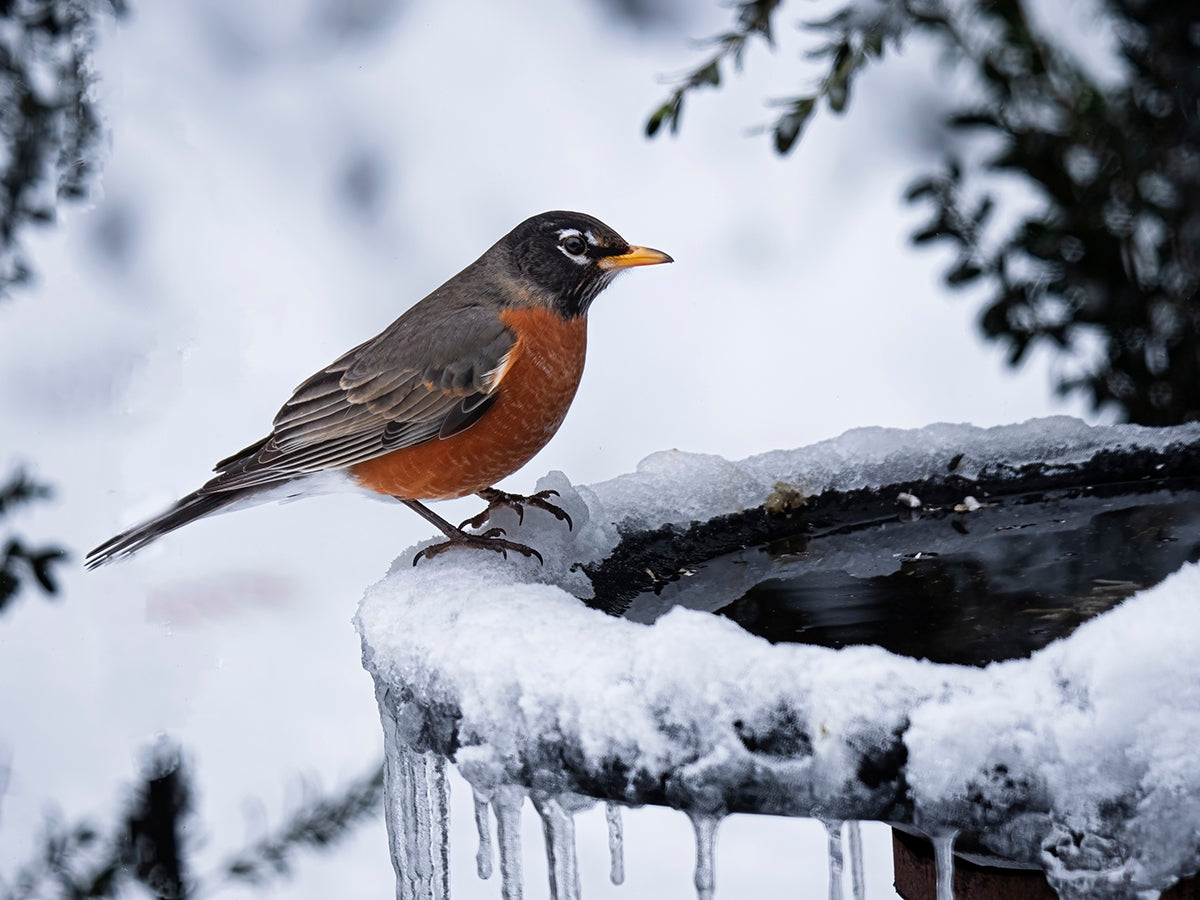
How to Keep Your Birdbath from Freezing
You kept your backyard birdbath filled all summer. You cleaned it when necessary and were rewarded with many delightful bird sightings. And the birdbath "rewarded" the birds with a reliable water source they could count on.

But what happens when you and the birds wake up to a chilly, sub 32°F morning and a brittle ring of ice around the birdbath? Maybe it's even completely frozen over. What should your next move be? Is it time to put the birdbath away for the season, or do you need to try to keep it from freezing all winter? They've probably come to depend on it if you supplied them with water during warmer weather. So it's important to keep doing so, even in the winter. Keep reading to learn why.
Birds Benefit from Fresh Water
We all know snow is just water in a frozen, crystalized state. While it is possible for wild birds to eat snow for their hydration, that hydration comes at a cost. Snow's volume is mostly air pockets. What looks to be a decent amount of snow melts into a relatively tiny amount of water. A bird needs to consume a fair amount of snow to get enough water, and melting it requires body heat. It works, but it's not very satisfying and costs the bird warmth and calories right at a time of the year when both are critical.
It's much more efficient for birds to consume water already in a liquid state, which you can provide in a thawed birdbath. This could be especially important if the birds are already in the habit of drinking from a specific spot. To help keep bird feet and feathers dry (minimizing exposure to cold), you could place a grill over the birdbath so they may drink freely without fear of getting damp. Stones or large sticks in the birdbath also work for this while giving a natural appearance the birds may prefer.
Birdbath Heaters to Try
If your winters are quite cold, or you want to be able to keep the birdbath thawed easily, you might need a heater to keep the water thawed during really chilly days and nights. This might apply if you live in USDA Hardiness Zones 1-8. Luckily, there are products just for that:
- Use a birdbath heater. The K&H Super Ice Eliminator Bird Bath Deicer can be submerged right in the bottom of a birdbath, and the thermostatically-controlled heater will automatically keep the water ice-free, even if it gets really cold. Designed to look like a stone, it offers a natural-looking option and only uses 50 or 80 watts of power, depending on the size you choose. You can also use bucket heaters, like the K&H Perfect Bucket Heater, designed similarly to birdbath heaters.

- Try a heater under the birdbath. For birdbaths with a flat-bottomed bowl (either without a stand or with a removable one), you might have success with a K&H Universal Waterer Deicer. While commonly used for livestock water containers, this deicer is perfect to use as a birdbath heater, depending on the specific situation. Again, a built-in thermostat means the heater only functions when needed, and it's a gentle 80 watts when running.

- Run a pond heater for larger water features. If you keep a garden pond to attract the birds (or perhaps keep koi fish), you can probably keep it ice-free with a K&H Thermo-Pond Perfect Climate Deluxe Pond Deicer. This way, the birds can continue to enjoy your water feature throughout the cold season.

DIY Techniques to Try
You can also try to keep your birdbath thawed using only simple DIY techniques (i.e., no electricity). These methods tend to work best in warmer regions (perhaps USDA Hardiness Zone 9-13) that only experience brief dips of below-freezing temperatures in the winter.
You could try to:
- Use the sun. Sunlight may not feel that warm on a cold winter day, but it actually puts out a surprising amount of thermal energy. So place your birdbath somewhere where it can receive direct sunlight, not in the shade of a building or tree, to help keep the water thawed.
- Use a dark-colored birdbath. Take the solar method a step further by using a birdbath made of a dark material that more efficiently collects and stores warmth from the sun.
- Keep it filled up. Ever notice how a small mud puddle in the driveway freezes quickly in the winter, but a large lake can take days to freeze? It has to do with water volume — the more water, the longer it retains heat. Put the same basic science to work in your birdbath by refilling often. Go a step further and fill it with lukewarm water to extend the time before freezing. (Take care not to make the water too hot, or you could damage your birdbath.)
- Place something in the birdbath to float. As the wind moves the object around (perhaps a ping-pong ball or similar), the ripples can help stop ice from forming.
Help Birds Survive Winter
Wild birds have a tough challenge finding food and staying warm throughout the winter. Providing them with a reliable water source — and one you keep thawed with these simple tips — can help them survive and continue providing you with avian entertainment all winter long.

Leave a comment